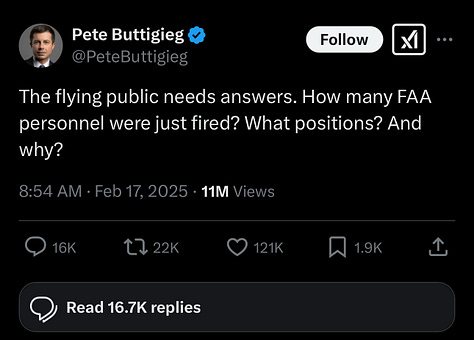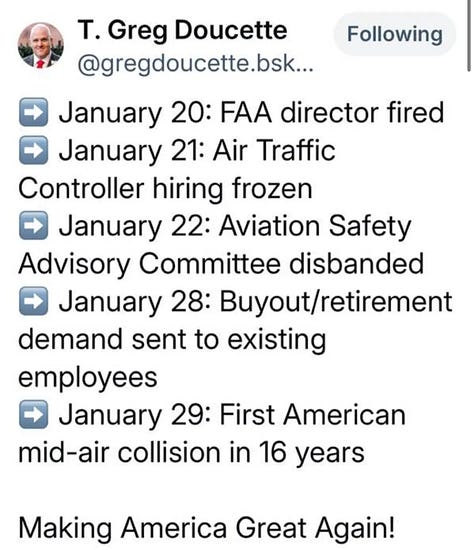1 - A Download on DOGE
Last week, DOGE dropped a bombshell that would make Smokey the Bear weep: nearly 5,000 Forest Service and National Park employees got pink slips faster than you can say "Don't feed the bears." We're not talking about redundant paperwork pushers here – these cuts hit the backbone of our national parks. EMTs? Gone. Wildlife specialists? Sayonara. Safety experts? See ya later (or maybe not, since there's no one left to say goodbye to).
The human cost is devastating. Imagine building your entire life around protecting America's most beautiful spaces, living off-grid in park housing, only to receive a "thanks for your service, now please vacate your home" notice. These aren't just jobs – they're lifestyles, vocations, and for many, their entire communities. It's like someone pressed delete on an entire ecosystem of park professionals.
But here's where it gets really interesting (and by interesting, I mean potentially catastrophic): Think about the economic domino effect. When you remove almost 5,000 steady government paychecks from the economy, you're not just affecting those families – you're impacting every local business they frequent, every school their kids attend, and every community they support. It's basic economics wrapped in a ranger hat: less income means less spending, means less economic activity, means... well, you get the picture.
And for what? So DOGE can proudly announce they've "reduced government spending"?
2 - The Federal Aviation Administration’s Troubling Turbulence
Since January 20th, a new pre-flight ritual has emerged across America: anxious text chains filled with prayer emojis and "land safe" wishes. While air travel has always carried inherent risks, the recent cascade of aviation incidents has even seasoned travelers clutching their armrests a little tighter. The question on everyone's minds: Why now?
The answer may lie in the recent seismic shifts at the Federal Aviation Administration (FAA). Under newly appointed Transportation Secretary Sean Duffy, the agency executed a swift and controversial purge of 400 employees. While Duffy maintains these were merely "probationary staff," the Professional Aviation Safety Specialists (PASS) union tells a different story: among those cut were maintenance mechanics and aviation safety assistants – the very people responsible for keeping our skies safe.
Duffy's defense comes with a curious deflection. In a statement punctuated with theatrical exclamation points, he blamed his predecessor: "Mayor Pete chose to use this amazing department as a slush fund for the green new scam and environmental justice nonsense. Not to mention that over 90% of the workforce under his leadership were working from home – including him. The building was empty!"
Is “!” the new punctuation to indicate a lie? Maybe the deflection of responsibility?



The cuts align with the Department of Government Efficiency's broader mission to slash federal workforce numbers in the name of "savings." While this might sound reasonable in a Business 101 textbook – where payroll is indeed the first target during budget crises – the reality is far more complex. Here's a sobering analogy: you can save money by not buying food, but you won't survive long enough to enjoy those savings.
This isn't just about budget lines and organizational charts. We're talking about the safety net protecting 2.9 million daily air passengers. These positions require specialized skills and years of experience – expertise that can't be measured in simple dollar signs or replaced with efficiency algorithms.
The current trajectory raises alarming questions about the future of aviation safety. With rumors swirling about potential loosening of automotive regulations for companies like Tesla, one has to wonder: are we witnessing the systematic dismantling of transportation safety standards in the name of "efficiency"?
For now, those prayer chain texts continue to multiply, serving as digital distress signals from an increasingly nervous flying public. Perhaps it's time to recognize that some government functions shouldn't be treated like a corporate cost-cutting exercise – especially when lives are quite literally up in the air.
3 - NikeSKIMS - The New Power Couple
I almost didn’t include this one. Not for any real reason other than my growing disinterest in celebrity culture. In a world seemingly run by technocrats and grifters thriving off the attention economy, it’s hard not to feel disconnected from things that prop up a version of the world that doesn’t quite support the rest of us. But we’re here to talk about consumer habits, and SKIMS is a fascinating case—one that blurs the lines between product consumption, content consumption, and, in a way, the consumption of other people’s lives. NikeSKIMS. A collaboration we didn’t see coming but, in hindsight, makes perfect sense. Nike could, in theory, collaborate with anyone.
So why SKIMS? We’ve seen SKIMS partner with brands like FENDI and The North Face—companies with legacy, prestige, and a dedicated consumer base. But this time, things look different. SKIMS didn’t just do another limited-edition drop or a scarcity-driven launch. NikeSKIMS feels less like a fleeting collaboration and more like a full-blown merger of brand identities.
“NikeSKIMS, a new brand from NIKE, Inc. and SKIMS, will disrupt the global fitness and activewear industry with best-in-class innovation in service of all women athletes.”
Keep reading with a 7-day free trial
Subscribe to Consumer Digest to keep reading this post and get 7 days of free access to the full post archives.






